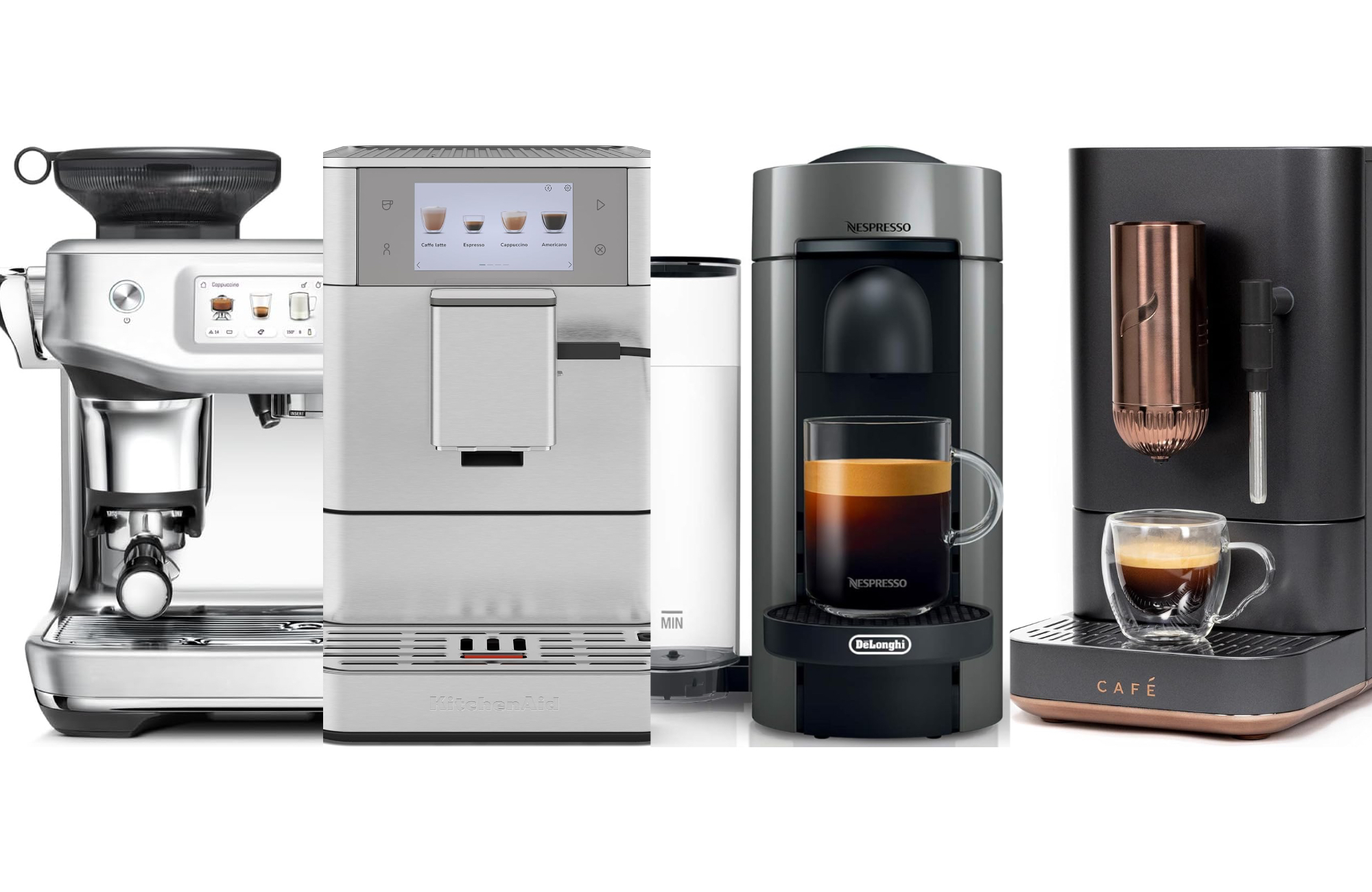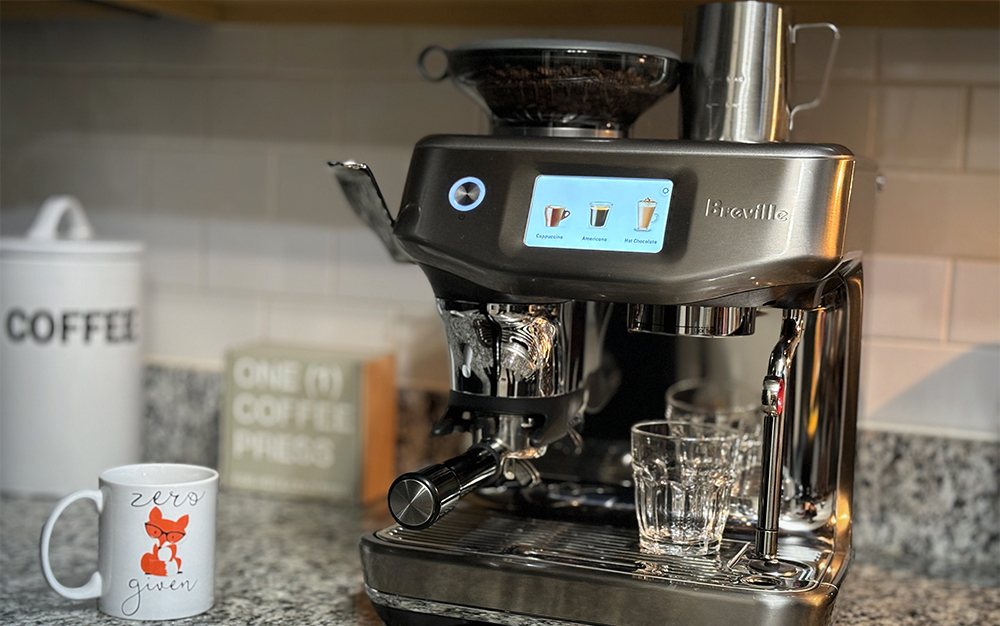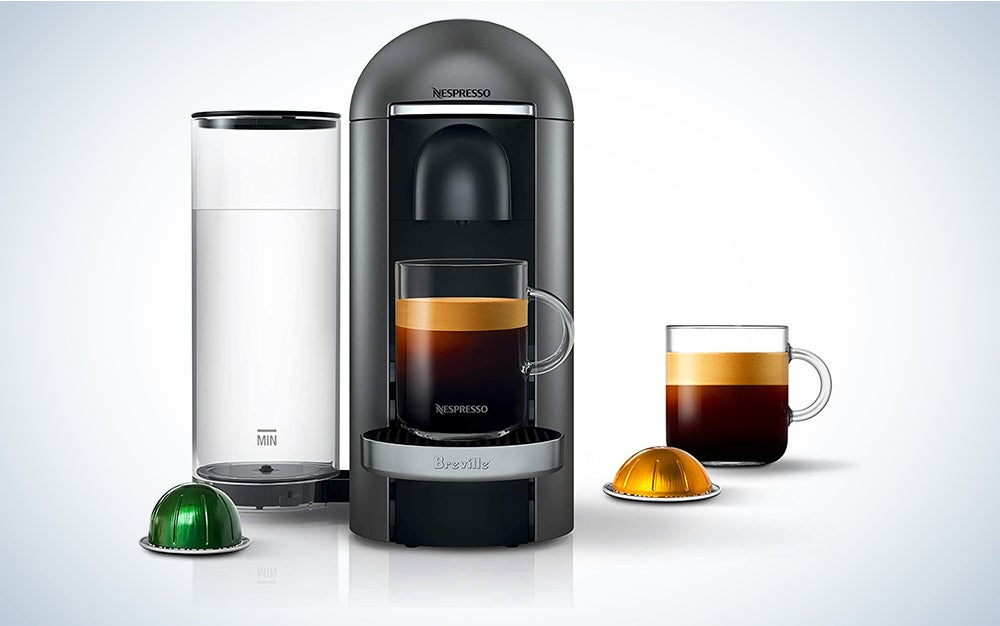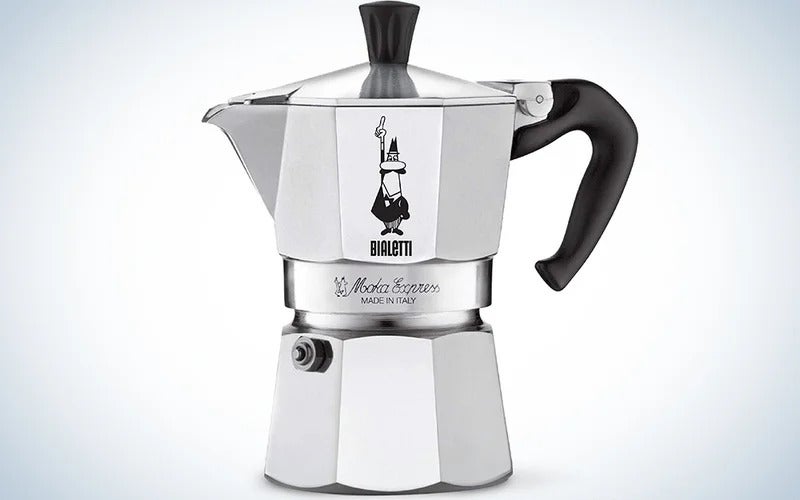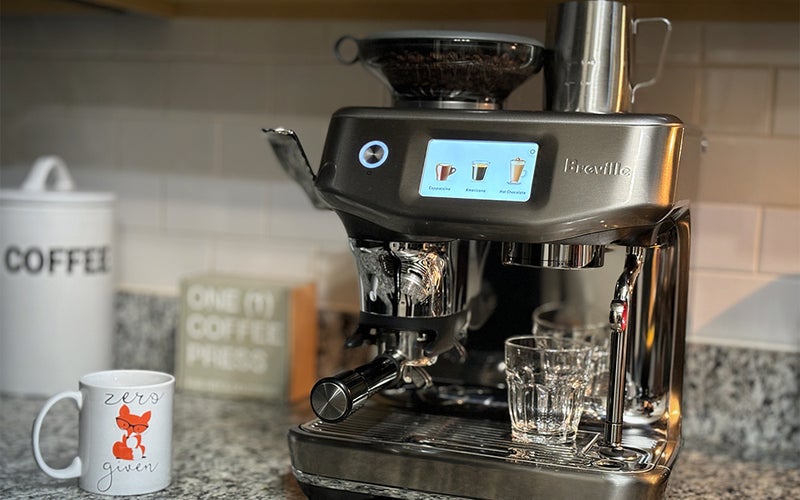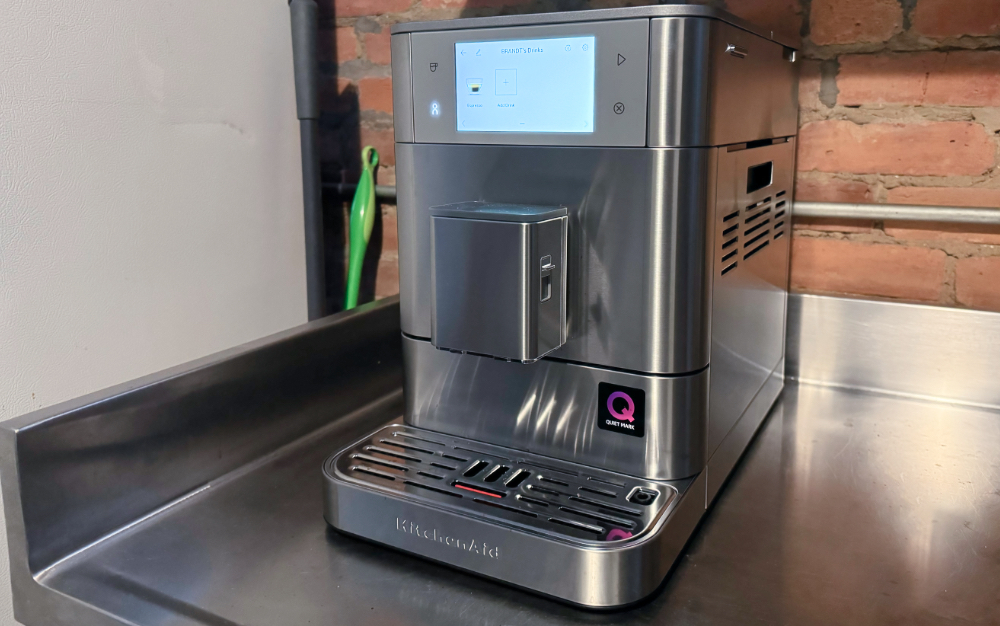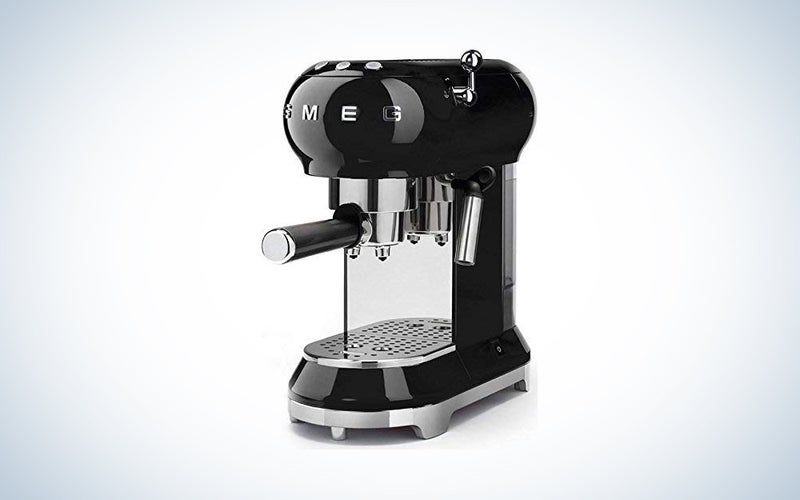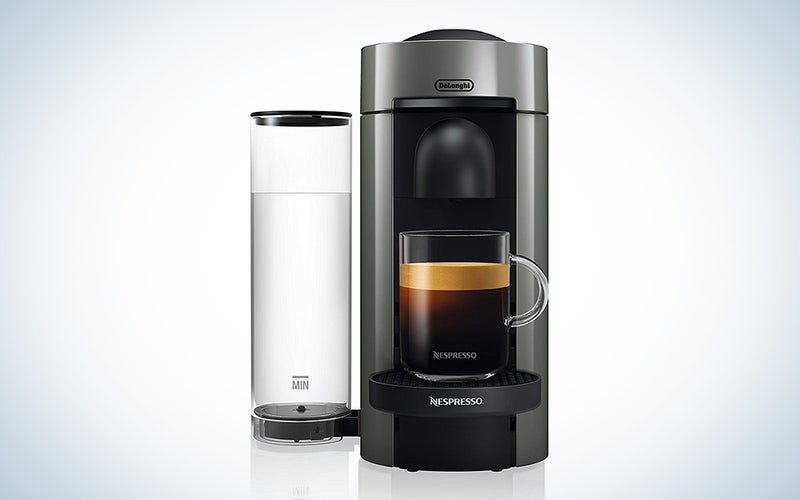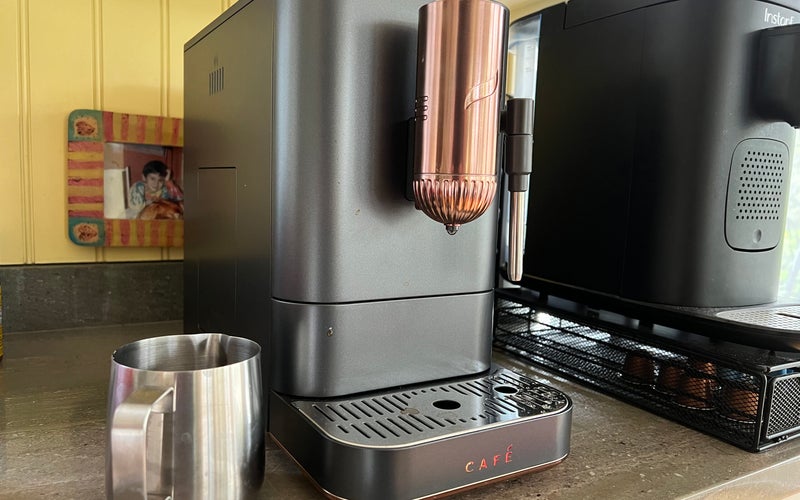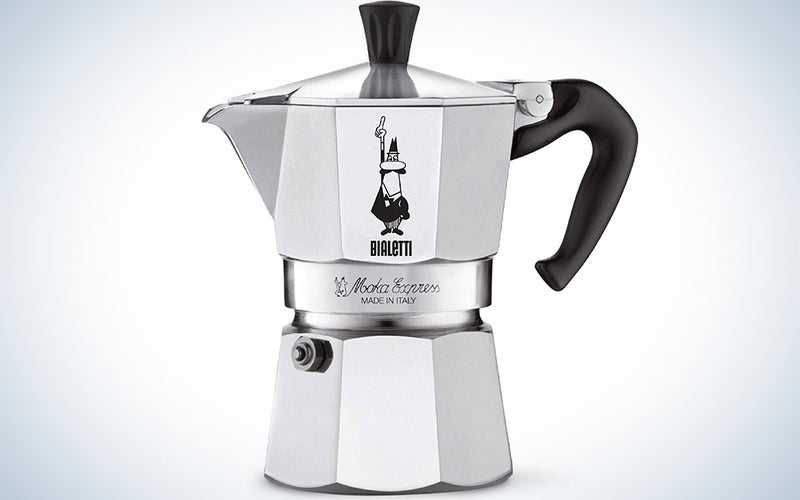We may earn revenue from the products available on this page and participate in affiliate programs. Learn more ›
Six bucks for a cappuccino? You’ve got to be kidding me. Coffee shops nowadays charge top dollar for espresso drinks; if you’ve got a daily milk and espresso habit, the cost will add up quickly. Imagine enjoying a cappuccino in the morning without waiting in line or speaking to a soul. Alternatively, imagine impressing guests at a dinner party by serving macchiatos with dessert. Espresso also tends to be less acidic than drip coffee, so many people find it to be easier on the gut and a pleasing digestif. Depending on how advanced you want to get, there are home espresso machines for the pro barista and layperson alike. Here are some of our favorites to help you start your search for the best espresso machines.
- Best overall: Breville Barista Touch Impress Espresso Machine with Grinder
- Best timesaver: KitchenAid KF8
- Best statement piece: Smeg Espresso Coffee Machine
- Best for beginners: Nespresso VertuoPlus Coffee and Espresso Machine by De’Longhi
- Easiest to use: Café Affetto Automatic Espresso Machine + Milk Frother
- Best budget: Bialetti Moka Express, Stovetop Coffee Maker, Aluminium, 9-Cup Espresso
How we chose the best espresso machines
As journalists constantly trying to meet deadlines, our minds are fueled by equal parts inspiration and desperation, but our bodies are 99.9 percent coffee. This means we have a thing or two to say about creating the coffee shop experience at home. To round out this roundup, we downed a double and had jittery discussions about our own brewing experiences, looked at product reviews, talked to coffee aficionados, and scoured coffee chat boards—yes, those exist—to find the best espresso machine for your home.
The best espresso machines: Reviews & Recommendations
Making a quality cup of joe or mug of latte takes more than hot purified water, freshly ground coffee, and time. Don’t get us wrong, we love our drip coffee and pour-over coffee makers, but we sometimes need the special energy and aura of perfectly textured crema. Take the temperature of any barista, and they’ll say hand-crafted beverages are both an art and a science. At the heart of all good coffee is a great shot of espresso, and at the core of great espresso is a great espresso machine—the exacting, expressive tool that lets you pull perfect shot after perfect shot in the comfort of your own home. Here are our picks so you won’t get steamed yourself looking for the perfect pressurized apparatus.
Best overall: Breville Barista Touch Impress Espresso Machine with Grinder
Tony Ware / Popular Science
Why it made the cut: This professional-grade espresso machine pulls no punches and pulls perfect espresso shots.
Specs
- Capacity: 67.6 fluid ounces
- Weight: 22 lbs.
- Dimensions: 12.9 x 13 x 16.4 inches
Pros
- Built-in grinder
- Assistye3d tamping
- Settings for alternative milks
- Saves up to eight customized drinks
Cons
- Cost
- Requires substantial counterspace
Breville’s Impress is the most, well, impressive latte machine we’ve tested, and it’s also our favorite for making espresso. The machine was designed to be beginner-friendly, with most of the drink-making process being automatic. This starts with selecting your drink of choice from the Impress’ touchscreen, at which point its built-in burr grinder (which can be fine-tuned for various factors) will automatically portion out your grounds. A lever allows you to use the espresso machine’s integrated 22-pound tamper. If everything seems in order—the Impress will show a green checkmark on its screen—you move the portafilter to its brew head, and the Impress takes care of the rest.
If your drink requires milk, use this espresso machine’s built-in frothing wand and milk jug. Breville’s “MillQ” system has temperature + aeration presets for different alternative milks, including almond and oat milk. In this case, the Impress is not automatic: You’ll decide how much milk you need and how much to pour. Markers on the milk jug will show you its minimum and maximum capacity, but that’s all the guidance you’ll get. It may take a few tries to get the perfect macchiato, but this won’t be an issue once you’re comfortable making your preferred drinks.
The Barista Touch Impress isn’t fully automatic, but it will keep you from making common mistakes by telling you things like letting you know your coffee puck needs to be tamped again or letting you know when the portafilter isn’t full enough. Gauging the pressure it took to establish a steady flow of expresso, it will give you suggestions on grind size to help you achieve a more consistent result. Many of these errors will be displayed on its display or denoted by pronounced beeps, taking some of the guessing game out of pulling off the perfect grind, and helping keep your countertops clean, too, since you’re only transporting the grounds above the drip tray. This espresso machine isn’t perfect—it costs $1,500 and can only accommodate a standard-sized mug under its brew head—but its beginner-friendly nature and overall design are hard to beat. That’s why we’ve also named it the best splurge if you’re looking at coffee machines for offices.
Best timesaver: KitchenAid KF8
Brandt Ranj / Popular Science
Why it made the cut: The KitchenAid KF8 is the automatic espresso machine you’ve always dreamed of.
Specs
- Capacity: 2.2 liters
- Weight: 27 lbs.
- Dimensions: 14.3″ H x 10.2″ W x 18.5″ D
Pros
- Makes drinks with the push of two buttons
- Plant-based milk options
- Support for up to six user profiles
- Capable of making variations of popular drinks
- Quiet-Mark Certified
Cons
- Price
- Requires a deep countertop
KitchenAid’s KF8 may not unseat its stand mixer as the company’s crown jewel, but there’s a good case to be made that it should. The fully automatic espresso machine allows you to make drinks in a couple of minutes that baristas spend years training to perfect. If you’re intimidated by making coffee for fear of screwing up nice beans (guilty), you’ll appreciate how the KF8 is set up and use. Just be sure you have enough counter space (the KF8 is deeper than most espresso machines) before you begin.
This espresso machine’s centerpiece is its five-inch touchscreen, which allows you to select your preferred drink. Once selected, you can choose its strength, temperature, the type of milk you’re using (if applicable), and the size of your glass. We found that adjusting the strength setting did impact the way our drink tasted—strong brought out the most flavor from our beans—and liked the middle temperature setting the best, as we could enjoy our beverage immediately without the risk of totally burning our tongue and throat.
Once your drink and settings have been selected, the KF8 will use its built-in grinder to grind the beans, tamp them, and begin pouring the beverage. This entire process takes about a minute, and its progress is shown on the espresso machine’s display. Once the drink is complete, you can add it to a profile, where it’ll be accessible with a single tap. The KF8 has enough memory to save multiple drinks for several people, so homes with a few coffee drinkers can designate their presets. Beyond the KF8’s stellar performance—this machine made the best coffee drinks our tester has tried at home or from a café—the machine has several design features that make it stand out.
Its brew head can be moved vertically to accommodate different glass sizes. Its bean hopper is removable, which allows you to swap out different beans in a minute or two without wasting them. Its milk container attaches to the machine’s brew head using a flexible, removable tube that extracts the perfect amount based on your beverage. This container can be stored in your fridge between uses to prevent you from wasting milk. The KF8 even earned a Quiet-Mark certification, which was awarded to the machine due to how soft its grinder sounds while it’s working.
This espresso machine is undoubtedly a luxury at $1,999, but one that’s absolutely worth the additional cost for anyone who’s a perfectionist when it comes to coffee.
Best statement piece: Smeg Espresso Coffee Machine
Smeg
Why it made the cut: This espresso machine features a smaller profile for a minimalist kitchen.
Specs
- Capacity: 34 fluid ounces
- Weight: 11 lbs.
- Dimensions: 12 x 6 x 13 inches
Pros
- Passive cup warmer
- Slim
Cons
- No built-in grinder
This is a great option for someone who isn’t a pro barista but cares about their espresso and aesthetics. It is made of stainless steel with a filter holder for either espresso grounds or pods, depending on how involved you want to get. The control panel is easy to use with buttons for one cup, two cups, and steam. It also has a one-liter water tank that can be removed for filling. For the more detail-oriented espresso hound, this machine allows you to adjust water hardness and extraction length. The onboard chrome steam wand also makes it easy to froth milk for your fancier drinks. The Smeg, unfortunately, does not have an onboard grinder, so that’s something to consider—but don’t worry, we have plenty of suggestions for the best coffee grinders.
Best for beginners: Nespresso VertuoPlus Coffee and Espresso Machine by De’Longhi
Nespresso
Why it made the cut: This beginner-friendly machine makes barista-worthy shots.
Specs
- Capacity: 40 fluid ounces
- Weight: 9 lbs.
- Dimensions: 5.59 x 16.88 x 12.79 inches
Pros
- Hands-off
- Thin profile
Cons
- No steam wand
- Pod-only
This machine—our best overall choice among Nespresso machines—is great for home or office; just insert a Nespresso capsule, push a button, and watch it go. The Nespresso VertuoPlus offers options for single (1.35-ounce) espresso, double (2.7-ounce) espresso, or Americanos in 5-, 8-, or 14-ounce sizes. Any of these pours can be extracted from a single capsule. The removable water tank holds 40 ounces, and the used capsule container can store up to 12 pods before it needs emptying. This is a more hands-off option for somebody in search of a quick fix. The espresso drinks pour nicely with crema on top, but the VertuoPlus does not have a steam wand for milk. It comes with a complimentary assortment of 12 capsules to get you started.
Easiest to use: Café Affetto Automatic Espresso Machine + Milk Frother
Billy Cadden
Why it made the cut: This machine can make a custom cup to your liking; no mental math required.
Specs
- Capacity: 40.6 fluid ounces
- Weight: 19 lbs.
- Dimensions: 16.1 x 7.1 x 12.48 inches
Pros
- Brews in 90 seconds
- Compact
Cons
- Touch panel is very sensitive
- Water reservoir is hard to reach if you have low cabinets
Are you the person with the complicated coffee order because your cappuccino has to be a certain way? Are you also tired of paying for that customized cup multiple times a week but worried you don’t have time to get it right at home? Congrats, this machine is for you. This espresso machine is Wi-Fi-connected and syncs with the SmartHQ app, which allows you to customize drink preferences by volume and strength—ristretto and beyond. And your custom cup is available in 90 seconds at the push of a button. The froth wand rotates 90 degrees for control and convenience, and the included 15.8-ounce steel frothing pitcher includes liquid measurement engravings inside. A built-in conical burr grinder includes five levels of grind, from coarsest to finest, to prep your beans for pre-infusion, balanced extraction, and a consistent cup blooming with flavor. If you’re assembling a smart-home beverage station, this is the smart choice.
Best budget: Bialetti Moka Express, Stovetop Coffee Maker, Aluminium, 9-Cup Espresso
Bialetti
Why it made the cut: This moka pot proves that you don’t need a fancy machine to make a good cup of espresso.
Specs
- Capacity: 17 fluid ounces
- Weight: 2 lbs.
- Dimensions: 7.05 x 5.12 x 9.64 inches
Pros
- Zero-waste
- Hands-on
Cons
- Takes more time to make a shot
This is the old-school Italian way to make espresso at home, and it works like a charm. Just fill the lower chamber with cold water, add ground espresso to the filter, and screw the top chamber on. Put it on the stove over medium-low flame and let it bubble until the water travels through the grounds and into the top chamber. The result is delicious and complex, considering you don’t have to plug anything in. The Bialetti is compact to the point that you could travel with it, so it is quite the opposite of any of the other counter-space-eating espresso makers on the market. It’s the perfect compact cabinet-friendly complement to one of the best French press coffee makers. You will also want to keep it near your kitchen scale, coffee grinder, and milk frother, as nothing is built into this pot.
What to consider when buying the best espresso machines
Not all espresso machines are built alike. Here are some important considerations before purchasing the best espresso machine for you:
Price
Professional-style machines tend to cost more than ones meant for the regular consumer. If you just want to make a simple Caffè Americano or latte and don’t need bells and whistles like a milk frother or built-in grinder, don’t splurge on a barista’s dream espresso machine.
Size
Espresso machines can take up the same footprint as a more traditional coffee maker all the way to an entire wing of the counter, depending on the complexity of the machine. You may want a larger, professional-style machine, but before you purchase you need to make sure you have the counter set-up that can accommodate it.
Drink preferences
If you’re a mocha or cappuccino fan, you might benefit from a more technical machine that preserves the quality of the espresso. If you’re just trying to get some caffeine in your body and don’t care about the particulars, don’t worry about things like boilers and what temperature the machine gets to.
Related: Best coffee makers
FAQs
Q: What kinds of coffee can I make with an espresso machine?
Lots! You can make lattes, Caffè Americanos, cappuccinos, mochas … you name it, it’s possible with an espresso maker. The amount of steamed milk, foam, and espresso determines what kind of drink you will have. For example, an Americano is just espresso and hot water. Lattes and cappuccinos are both made from espresso, steamed milk, and milk foam, but the ratio of the three ingredients differentiates the two.
Q: What are some tips for using the espresso machine?
It depends on the kind of machine you have. But for a manual machine—the kind where you have to pull the shot—make sure you use fresh beans, clean your machine, and don’t use hard or untreated water when making a shot of espresso.
Q: How long do espresso machines last?
Depending on the quality, amount of use, and care, an espresso machine can last between 5-10 years.
Final thoughts on the best espresso machines
- Best overall: Breville the Barista Express Espresso Machine
- Best timesaver: KitchenAid KF8
- Best statement piece: Smeg Espresso Coffee Machine
- Best for beginners: Nespresso VertuoPlus Coffee and Espresso Machine by De’Longhi
- Easiest to use: Café Affetto Automatic Espresso Machine + Milk Frother
- Best budget: Bialetti Moka Express, Stovetop Coffee Maker, Aluminium, 9-Cup Espresso
Making your own coffee at home saves you money and adds to your morning ritual. Yes, being on a first-name basis with a barista is a great humblebrag. But so is engaging in small acts of mindfulness by paying attention to how each shot smells when it’s brewing and savoring every sip from your favorite travel coffee mug, knowing you are mastering the alchemy of espresso.
Why trust us
Popular Science started writing about technology more than 150 years ago. There was no such thing as “gadget writing” when we published our first issue in 1872, but if there was, our mission to demystify the world of innovation for everyday readers means we would have been all over it. Here in the present, PopSci is fully committed to helping readers navigate the increasingly intimidating array of devices on the market right now.
Our writers and editors have combined decades of experience covering and reviewing consumer electronics. We each have our own obsessive specialties—from high-end audio to video games to cameras and beyond—but when we’re reviewing devices outside of our immediate wheelhouses, we do our best to seek out trustworthy voices and opinions to help guide people to the very best recommendations. We know we don’t know everything, but we’re excited to live through the analysis paralysis that internet shopping can spur so readers don’t have to.
